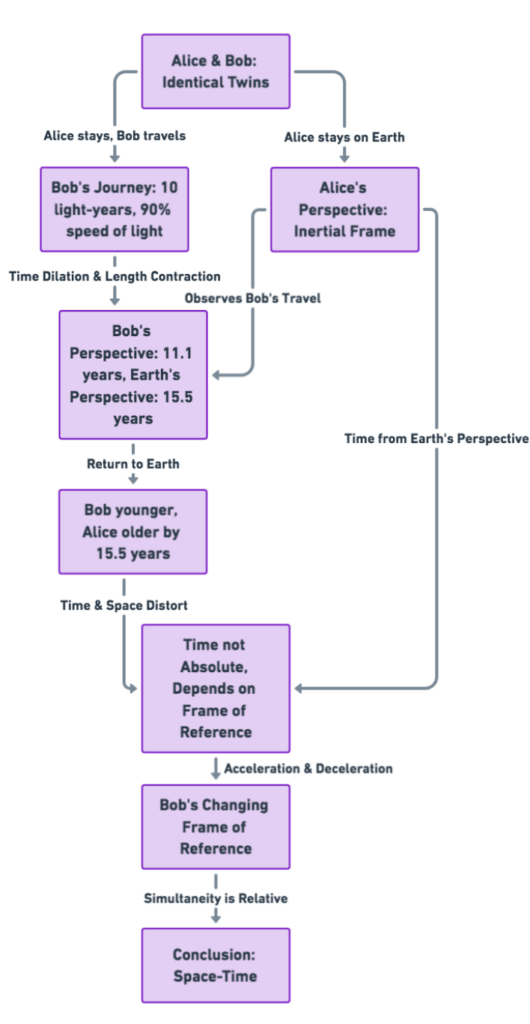The Twin Paradox is one of the most famous and intriguing thought experiments in physics, conceived by Albert Einstein in the early 20th century to illustrate the counter-intuitive effects of time and its relationship with the fabric of space, ultimately redefining the cosmos by no longer referring to it as space, but space-time. While Einstein’s theory of special relativity gave rise to the phenomenon of time dilation, the Twin Paradox as a thought experiment was truly unique and is one of the perfect examples of the way a free scientific mind should function.
Albert Einstein was born in 1879 in Ulm, Germany. His family moved to Munich the following year, where Einstein spent his childhood. From an early age, Einstein displayed a brilliant, creative mind and a rebellious spirit. Though bright in school, he rebelled at the rigid teaching methods and dropped out at age 15. He later completed his schooling and attended the Swiss Federal Polytechnic, where he met his first wife Mileva Maric.
After graduation, Einstein struggled to find work in academia and took a job as a patent clerk in Bern. It was during this time, a 26-year-old patent clerk published his revolutionary concepts that changed physics forever. Einstein’s proposed time dilation in 1905, the same miraculous year in which he published his groundbreaking papers on special relativity, Brownian motion, and the photoelectric effect. Although not initially accepted by the scientific community, Einstein’s concepts such as special relativity eventually expanded on the foundations of Newtonian mechanics, providing a deeper understanding of the physical world.
Einstein often challenged traditional assumptions in physics. His belief in steady-state theory, for example, contradicted the Big Bang theory despite evidence supporting an expanding universe. Although he finally conceded to the expanding universe, it was Einstein’s nonconformist thinking that allowed him to revolutionize physics multiple times over his 40 year career. Einstein’s genius was defined by imagination and intellectual freedom, and his ability to challenge the status quo provided endless opportunities.

Einstein’s use of thought experiments, or Gedankenexperiments, was a hallmark of his unique creative process. These imaginative scenarios allowed him to explore concepts that were beyond the realm of experimental testing during his time. For instance, he famously envisioned riding a beam of light and invisioned what electromagnetic waves would look like in that frame of reference. This seemingly fantastical idea led him to accurate conclusions about the nature of time and space.
The Twin Paradox imagines identical twins named Alice and Bob. Alice remains on Earth while Bob climbs aboard a spacecraft capable of near-light speed travel. Bob embarks on a journey to a distant star 10 light-years away, accelerating to 90% the speed of light.
Due to time dilation effects from Einstein’s theory of special relativity, time slows down for Bob during his high-speed voyage. From Bob’s perspective on board, the 10 light-year trip takes just 11.1 years – the distance contracts due to length contraction in his frame. But observers on Earth measure Bob’s travel time as closer to 15.5 years due to time dilation. When Bob decelerates and returns to Earth, he finds that Alice has aged much more than he has. By their clocks, Alice is 15.5 years older while Bob aged only 11.1 years during his roundtrip. The paradox is that Bob is now younger than his twin Alice, even though they were born at the same time and neither experienced any biological differences.
This highlights how time is not absolute – elapsed time depends on the observer’s frame of reference. In Bob’s spaceship frame, less time passed compared to Earth’s frame. Length contraction also causes distance to shrink in Bob’s frame versus Earth’s. The constancy of the speed of light in all frames requires time and space to distort.
Resolving the paradox recognizes that Bob underwent acceleration and deceleration during his journey which changes his frame of reference, while Alice remained in an inertial frame on Earth. Simply turning around does not allow one to truly compare clocks in the same frame and location. Einstein emphasized that simultaneity is relative – two events happening at the same time in one frame will not be simultaneous in another.
Albert Einstein’s clever thought experiments opened the door to reconsidering concepts once thought constant like time and space. The Twin Paradox inspired physicists to conceive even more intriguing scenarios pushing the boundaries of relativistic effects. With the advent of precise atomic clocks and fast travel in the 1960s, time dilation was conclusively verified in both experiments on aircraft and using muon particles. Einstein’s clever paradox had physicists struggling with understanding relativistic time long before direct evidence. The audacious ideas Einstein explored through experiments marked the beginning of a scientific revolution that transformed humanity’s comprehension of time, space, and the physical world.
Beyond special relativity, over the next decade Einstein continued expanding on his theories and formulated the general theory of relativity. This described gravity not as a force but as a curvature of spacetime caused by mass and energy. It led to bold predictions like the bending of starlight and expanding universe that were later confirmed. He also explained the photoelectric effect by quantizing light, paving the way for quantum physics.

Furthermore, his initial thought process eventually led to the fact that strong gravitational fields also dilate time. What if one twin lived on a world with gravity millions of times stronger than Earth’s? They would return younger while the normal-gravity twin had become ancient. Varying gravitational forces around black holes could create even more radical time distortions. Though practical issues abound, manipulating gravity could one day allow effective time travel.
In relation to Einstein’s thought experiments, what thought processes can we create today that could lead to the next big discovery? Could we imagine a universe without Einstein’s cosmic speed limit of c (the spreed of light)? Sometimes reverse engineering or eliminating factors can highlight the importance of another.
Without space-time merged as one, accelerating to faster velocities would not increase mass or dilate time. One twin could embark on a near light-speed round trip to a distant star and would return at the same Earth-time perspective.
Exploring such an imaginary universe highlights why c critically shapes space-time and sets lightspeed as the maximum acceleration. Einstein’s ingenious thought experiments pushed us to reconceive reality. By continuing to dream up new thought experiments, we can push the boundaries of knowledge and wrestle with the deepest mysteries of time, relativity, and the quantum realm.
Thought experiments allow us to imagine extreme concepts to test physically. They spark new perspectives by training our intuition. As Einstein commented, “To raise new questions, new possibilities, to regard old problems from a new angle, requires creative imagination and marks real progress.”
Today thought experiments remain a staple of theoretical physics. From Schrödinger’s cat to Maxwell’s demon, imagined scenarios reveal truths impossible through observation alone. They enable revolutions in our conceptual frameworks. Einstein proved the power of mind experiments for illustrating reality’s deepest workings. His boldness to question assumptions through creativity and imagination continues to inspire physicists to consider new thought experiments that push boundaries and redefine our notions of reality.
“Imagination is more important than knowledge. Knowledge is limited. Imagination encircles the world.” – Albert Einstein
Like Einstein, do not be constrained by current dogma. Dream up thought experiments to explore exotic possibilities beyond what we can presently test. Allow your unbound creativity to traverse realms where no scientist has gone before. The greatest breakthroughs emerge from questioning assumptions and thinking differently. Your imagination is a powerful tool for advancing science. Let bold thought experiments lead you to fresh insights that reshape human knowledge. The limits of knowledge come from the absence of imagination. Your mind alone may reveal truths the physical world cannot.
By decisively following the implications of his theories through imagination, Einstein’s uncompromising creativity led him to these groundbreaking insights into the fabric of time itself. The Twin Paradox vividly illustrates the bizarre consequences of Einstein’s revolutionary ideas on time dilation. By considering this puzzle, Einstein helped overturn classical physics and usher in the era of modern physics and relativity. By continuing to ponder imaginative thought experiments, we gain insight into the fabric of reality.
Do not get discouraged. Many of Einstein’s ideas were initially met with skepticism, experiments and observation later vindicated them, making Einstein one of the most influential physicists in history.






